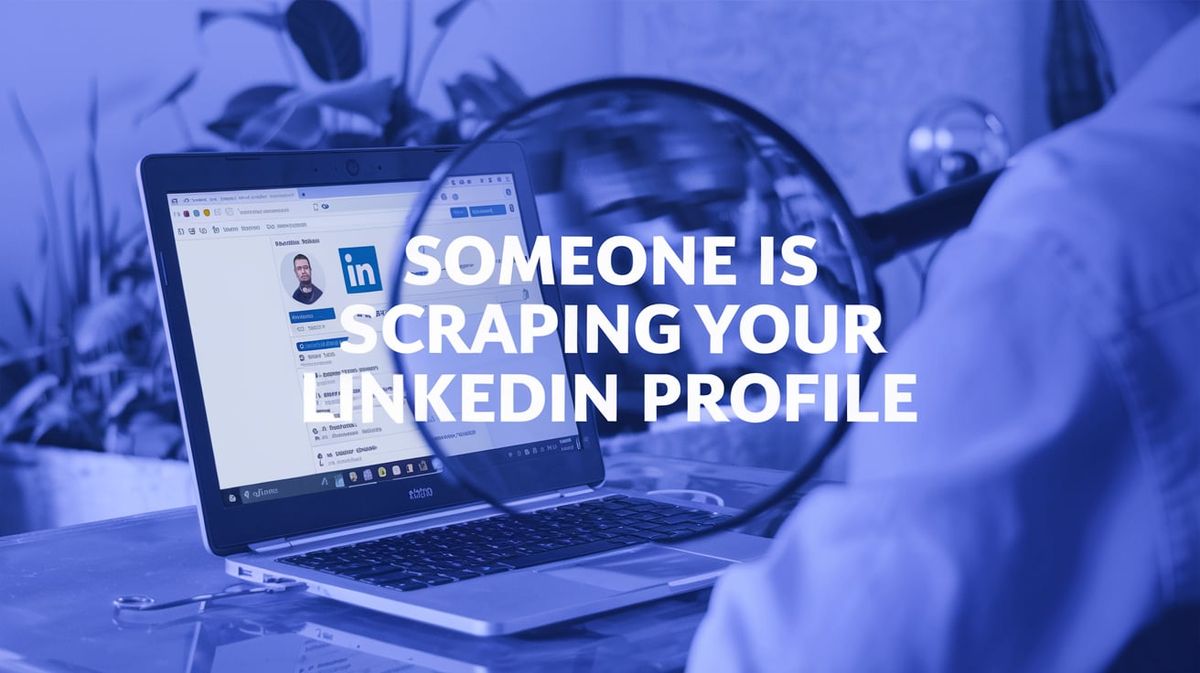LinkedIn is an incredibly valuable resource for professionals seeking to network, find jobs, or simply keep up-to-date on industry trends. However, it's also a goldmine of data—data that some people might want to collect without your explicit consent. This process is known as web scraping, and it's not just restricted to huge websites; individual LinkedIn profiles are often the targets too.

Understanding Web Scraping
Web scraping is the process of extracting data from a website. While it's not always done for malicious reasons, scraping a LinkedIn profile without consent could be considered a breach of privacy. LinkedIn itself takes the issue seriously and has implemented various measures to prevent scraping. However, it is still possible for someone to bypass these security measures to collect information about you.
Signs Your Profile is Being Scraped
Multiple Profile Views from Unrelated Connections
If you notice an influx of profile views from people who don't seem to have any common connections or interests, this could be a red flag. It's common for scrapers to collect data from a wide range of profiles quickly.
Immediate Follow-Up Messages
Some scrapers not only gather information from your profile but also send automated messages shortly after viewing your page. If you receive a connection request or message that seems overly generic or irrelevant to your field, it may be an automated scraping tool.
Frequent Profile Views from the Same User
While repeated profile views could be an indicator of genuine interest, it may also be a sign of scraping, particularly if this activity occurs in a short period.
Suspicious Activity on Your Profile
If you've added any external links to your LinkedIn profile, such as a personal website or portfolio, monitoring the traffic to these sites can provide insight into scraping activity. An unusually high number of referrals from LinkedIn could be a red flag.
Steps to Protect Your Linkedin Profile
Keep Your Profile Private
Limit the visibility of your profile to only your connections or network. You can change these settings through the LinkedIn privacy settings.
Report Suspicious Users
If you notice recurring suspicious activity, report it to LinkedIn. They have a vested interest in stopping scrapers to protect user data and experience.
Be Mindful of What You Share
The less you share, the less there is to scrape. Be mindful of what you're putting out there and whom you're sharing it with.
Enable Two-Factor Authentication
While this won't prevent scraping directly, it will add an extra layer of security to your account, making it harder for scrapers to gain unauthorized access.
Monitor Linked Accounts
If you've connected other accounts or a personal website to your LinkedIn, keep an eye on those platforms as well for signs of scraping or suspicious activity.
The increasing value of data makes it more likely than ever that your LinkedIn profile could be scraped. Being vigilant, knowing the signs of scraping, and taking protective measures can help you keep your information secure. If you suspect that you're a target, don't hesitate to take action by reporting suspicious activity to LinkedIn and strengthening your privacy settings. By being proactive, you can better protect your professional data and peace of mind.
What is LinkedIn Profile Scraping?
LinkedIn Profile Scraping is the process of using automated tools to extract information from individual LinkedIn profiles. This activity is generally considered to be against LinkedIn's terms of service.
Is LinkedIn Profile Scraping Legal?
LinkedIn Profile Scraping is a complex issue with legal ramifications. Generally, scraping a LinkedIn profile without explicit permission violates LinkedIn's User Agreement. Some jurisdictions also consider unauthorized data scraping to be a violation of computer fraud and abuse laws.
Why Would Someone Scrape My LinkedIn Profile?
Reasons can vary. Some entities scrape LinkedIn profiles for data analysis, market research, or lead generation. However, there can be malicious reasons too, such as identity theft or phishing attempts. Regardless of the intent, it's a practice that raises ethical and privacy concerns.
How Can I Identify if My Profile is Being Scraped?
- Unusual Profile View Patterns: A sudden or consistent view of your profile from unrelated profiles.
- Generic Immediate Follow-Up Messages: Receiving generic or irrelevant messages right after someone has viewed your profile.
- Multiple Views from the Same User: Especially in a short period, could be a red flag.
- Referral Data: If you have external links on your LinkedIn profile, high numbers of referrals could indicate scraping.
What Can I Do if I Suspect My Profile is Being Scraped?
- Adjust Privacy Settings: Limit who can see your profile and updates.
- Enable Two-Factor Authentication: For added security against unauthorized access.
- Report to LinkedIn: Use LinkedIn's reporting feature to report suspicious activity.
- Be Cautious with External Links: Monitor traffic on any external websites linked on your LinkedIn profile.
How Does LinkedIn Prevent Scraping?
LinkedIn has implemented several technical measures to prevent scraping, such as rate limiting, CAPTCHA challenges, and more. They also actively monitor for suspicious behavior and may take legal actions against violators.
At the end, you can read our how to prevent website scraping.

